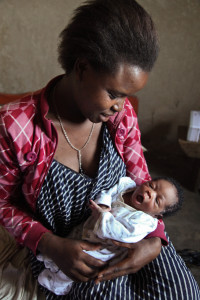
WESTPORT, Conn. — A baby’s birth day is the most dangerous day of life in the United States and almost every country in the world according Save the Children’s State of the Worlds Mothers report, released this week.
More than 1 million babies die the day they are born yearly, according to the first global analysis of newborn day-of-death data.
In addition to new findings on newborn survival, the report also features Save the Children’s Mothers Index, released annually in the run-up to Mother’s Day. This year it ranks Finland as the best place in the world to be a mother, and Democratic Republic of the Congo as the toughest.
The United States ranks as the 30th best place to be a mother, just above Japan and South Korea but below all of Western Europe, Australia, Slovenia, Singapore, New Zealand, Estonia, Canada, Czech Republic, Israel, Belarus, Lithuania and Poland. The Mothers Index rankings are determined by five indicators on education, income, women’s political representation and the chances a mother and her baby will survive.
Surviving the First Day
The 2013 State of the World’s Mothers report focuses in on newborn health and the theme Surviving the First Day. A new Birth Day Risk Index ranks 186 countries by the chances a baby will die on the first day of life.
The United States is a riskier place to be born than 68 other countries, according to the new analysis conducted by Save the Children and the London School of Hygiene & Tropical Medicine.
In the industrialized world, the United States has 60 percent of all first-day deaths, but only 38 percent of live births. Approximately 11,300 U.S. babies died on the first day of life in 2011, the report says. Some U.S. counties have first-day death rates common in the developing world, where 98 percent of all first-day deaths occur.
“It is hard to imagine the depth of one mother’s pain in losing her baby the very day she gives birth, let alone a million times over,” said Carolyn Miles, President & CEO of Save the Children. “Yet, this report is full of hope. It shows there is a growing movement to save newborn lives and growing evidence that we can do it saving up to 75 percent of them with no intensive care whatsoever.”
As child mortality drops, newborns left behind
Since 1990, overall child mortality has dropped dramatically around the world, from 12 million annual deaths to less than 7 million. But the report shows lack of global attention on newborns has translated into a much slower decline in newborn mortality. In sub-Saharan Africa, as many newborns die now as two decades ago.
Globally, 43 percent of child deaths occur in the newborn period, or first month of life. The new report finds that more than a third of newborn deaths, or 15 percent of all child deaths, occur on the same day – their first.
The three leading causes of newborn death are prematurity, birth complications and severe infections. Among wealthier countries, higher U.S. rates of prematurity contribute to higher newborn mortality. Whether in the United States or the developing world, the poorest mothers are more likely to lose a newborn baby, the report finds.
The largest numbers of first-day deaths occur in India (more than 300,000 a year) and Nigeria (almost 90,000). The report identifies Somalia as the country with the highest first-day death rate (18 per 1,000 live births), while Luxemburg, Singapore and Sweden have among the lowest (less than 0.5 per 1,000).
New hope for newborns
A new Save the Children analysis shows that four underutilized products costing between 13 cents and $6 each could save 1 million newborns a year many on the first day of life. They are:
– resuscitation devices to help babies breathe;
– the antiseptic chlorhexidine to prevent umbilical cord infections;
– injectable antibiotics to treat infections; and
– antenatal steroid injections to help preterm babies lungs develop.
Other factors the report says will save more newborns are:
– early and exclusive breastfeeding,
– kangaroo mother care to keep preterm babies warm against their mothers skin, and
– skilled attendance at birth (40 million women a year now go without).
Addressing the global health worker crisis is key, as is investing in girls and women. Their improved nutrition and empowerment to attend school, delay marriage and plan and space births all lead to healthier mothers and babies.
Celebrities speak up for Moms everywhere
Save the Children also debuted a video of celebrity and everyday moms celebrating the magical first moments with their babies and wishing the same for all moms.
”I’m grateful for the midwives who delivered my three children,” Save the Children Artist Ambassador Jennifer Connelly says in the video. “I hope that pregnant women everywhere are given the opportunity to give birth safely.”
Save the Children Artist Ambassador Jennifer Garner says, ”Even with all of the care I had, even with monitoring the babies all the way through, I still had fears. So it’s hard not to think about women who don’t have all of that care, and how scared they must be.”
The State of the Worlds Mothers report highlights several very poor countries making great strides to save newborns including Nepal, Bangladesh, Malawi and Ethiopia and calls on all nations to act for mothers and babies.
See the full rankings, learn more and take action at www.savethechildren.org/mothers
Save the Children is the leading independent organization for children in need, with programs in 120 countries, including the United States. Follow on Twitter and Facebook.



